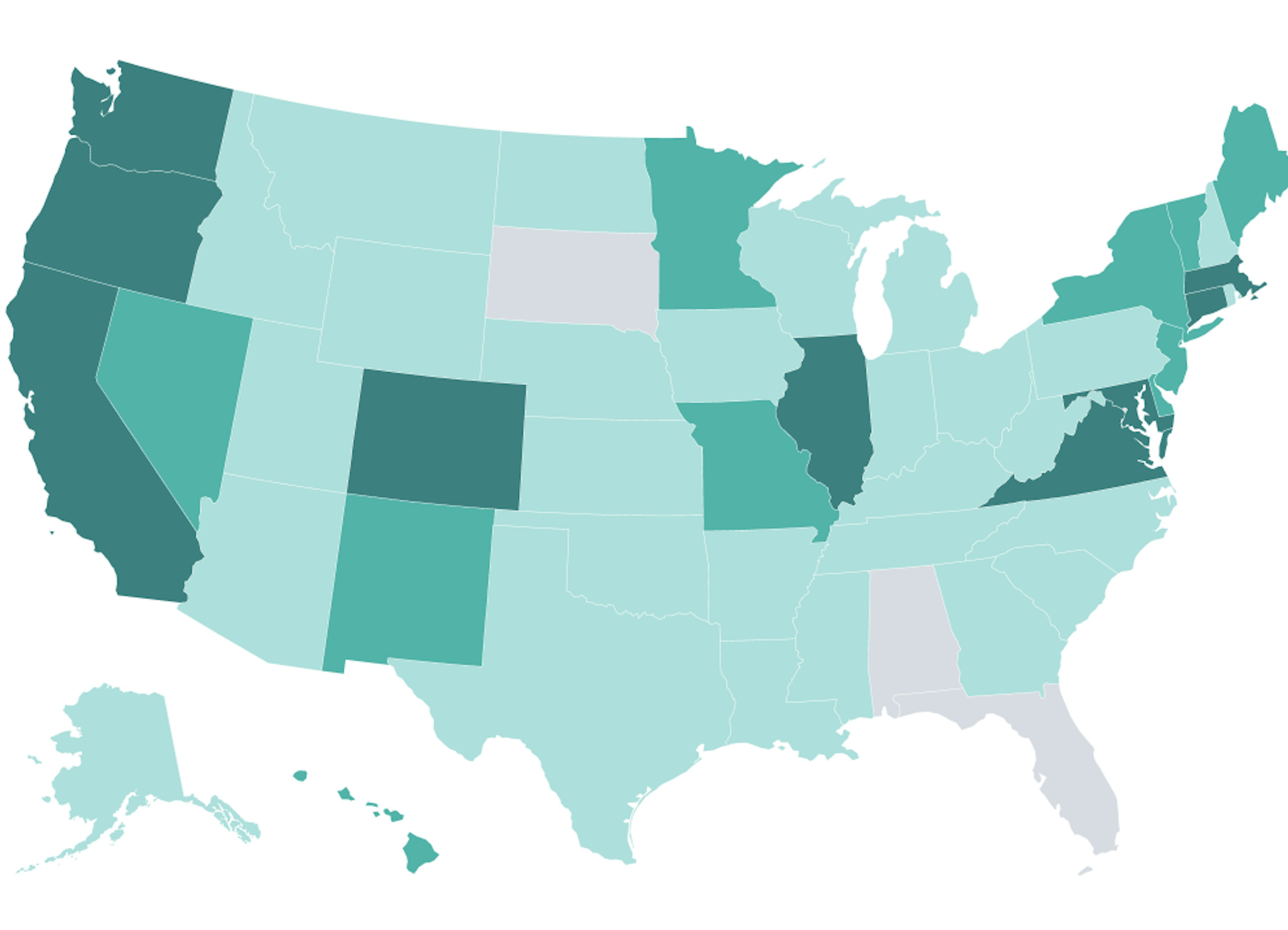Key Takeaways
MarylandSaves will require eligible employers to establish a retirement savings plan for their employees
The state-provided Roth IRA plan is the first to include retirement income and emergency savings components
The program opened to the public on September 15, 2022
For many, being able to retire is one of the most significant financial goals to aim for throughout a lifetime of working. Although some lean heavily on the promise of Social Security income, the majority of the working public is beginning to realize the importance of building up adequate savings and investment portfolios before leaving the workforce.
However, a 2018 study conducted by the Center for Financial Services Innovation found that 42% of adults aren’t setting aside anything for retirement. One of the driving forces behind this trend revolves around the accessibility of employer-sponsored retirement plans.
While some employers offer tax-deferred and tax-advantaged savings plans, unfortunately, many small businesses do not always provide this option as a benefit to workers. This may be due to a lack of understanding of the process, administrative headaches, or limited resources.
Fortunately, a growing number of states have enacted laws in recent years to help solve this retirement savings conundrum for both employees and employers. Maryland is one such state. MarylandSaves became available on September 15, 2022. Here’s a quick history of the bill, what’s offered under the program, and the current state of implementation.
State option or Human Interest 401(k): What's right for you?
Read our free guide to compare the Maryland Small Business Savings auto-IRA with a 401(k) plan.
MarylandSaves: Program details
In February 2016, the Maryland Small Business Retirement Savings Program and Trust was introduced in the House. The bill was designed to create a mandate for certain private-sector employers in the state to establish a retirement savings plan for eligible employees. Maryland’s Governor, Larry Hogan, described the bill as an initiative to help boost retirement savings for small business employees, without putting an excessive cost burden on employers.
In November 2021, Josh Gotbaum, chair of the Maryland Small Business Retirement Savings Program, announced that MarylandSaves would offer an automatic workplace retirement and emergency savings program. On September 15, 2022, Maryland began providing access to retirement savings through Roth Individual Retirement Accounts (Roth IRAs), referred to as WorkLife accounts, and was the first state to include retirement income and emergency savings components.
In September 2022, MarylandSaves was made available to the public (deadlines are still forthcoming). To register for the program, employers can go to the website and enter some basic information, including an access code that the program is sending to eligible businesses. Businesses can register as exempt if they already provide a retirement savings account to employees.
What’s offered under MarylandSaves
MarylandSaves provides access to retirement savings through automatic Roth IRAs to eligible employees of specific, private-sector small businesses. Under the law, employers with an automatic payroll system are required to establish a payroll deposit retirement savings arrangement for employees through a state-run trust. This means that employers that use an automated payroll system must offer a retirement plan or sign their employees up for MarylandSaves.
Businesses have no payment obligations, no federal reporting requirements, and will pay nothing to MarylandSaves for the service. Businesses may also receive a $300 waiver of the Maryland business annual filing. To qualify for the 2022 calendar year, businesses must be enrolled in MarylandSaves or another qualified plan by December 31, 2022. Businesses can then claim the waiver when filing taxes the following year.
State option or Human Interest 401(k): What's right for you?
Read our free guide to compare the Maryland Small Business Savings auto-IRA with a 401(k) plan.
MarylandSaves: Requirements and provisions
In addition to the specifics of what’s offered through MarylandSaves, the bill outlines specific requirements and provisions of which employers and employees should be aware. The most notable revolve around which small businesses are required to participate in the plan.
Employers that must enroll in MarylandSaves or 401(k) alternative
Any private-sector, for-profit, or nonprofit business operating in the state of Maryland that meets the following criteria must participate in the plan:
Those that pay employees through a payroll system or service
Businesses in operation at least two years
Businesses that do not currently offer an employer-sponsored retirement savings arrangement to employees
Businesses that have not provided a retirement savings plan in the last two years
It’s important to note that small businesses that meet these criteria may opt to establish their own retirement savings program for employees as an alternative to MarylandSaves.
Learn more about MarylandSaves alternatives:
Use our calculator to see how much a 401(k) would cost with SECURE Act tax credits applied.
Read more about the fees associated with launching and maintaining a 401(k) plan for your business.
MarylandSaves and employees
Workers must be at least 18 years old to participate, and cannot have access to an employer-sponsored retirement plan. MarylandSaves requires automatic enrollment for employees, but employees may opt-out of the plan at any time. Employees can withdraw funds, choose investment options, and change their savings amount. Accounts are portable, meaning that savers may keep them when they change jobs.
When enrolled in MarylandSaves, participant funds are deposited into an emergency savings account until it reaches a balance of $1,000. The emergency savings account is referred to as the MarylandSaves Capital Preservation Investment Option, which is 100% invested in the Guaranteed Investment Contract issued by The Lincoln National Life Insurance Company. It has a guaranteed interest rate of 2.00% through December 31, 2022, and an annualized asset-based fee of 0.28%.
After the emergency savings account is funded, participant contributions will be invested in an age-appropriate target date fund (other investment options include an income fund and growth fund).
A unique feature of the program, the MarylandSaves Social Security Bridge option will allow participants to increase their Social Security benefits by deferring their Social Security enrollment and receiving MarylandSaves funds instead.
According to MarylandSaves, many Americans claim Social Security benefits before the full retirement age of 67, which prohibits them from receiving full benefits. The program could help increase Social Security benefits by 8% each year participants choose to defer their payments.
MarylandSaves has set an initial default contribution rate of 5% of an employee’s pay, with automatic 1% annual increases (up to a maximum of 10%). Once the program is in place, employees may select the amount they wish to save through paycheck deferrals, up to the annual contribution maximum. For 2025, the IRS contribution limit to traditional IRAs and Roth IRAs is $7,000 ($8,000 if a participant is age 50 or older). Because there are income restrictions on eligibility to contribute to Roth IRAs, some employees may not be eligible to save for their retirement through the MarylandSaves program.
MarylandSaves plan provisions
Above and beyond employer and employee guidelines, MarylandSaves also puts into place several regulations for how the program is run over time. The board of the trust and its staff are charged with creating a retirement savings plan that works in the interest of plan participants, not the state or small business employers.
Additionally, a written investment policy is required, including details surrounding risk management and ongoing oversight of the program. The program is not funded by employer contributions but, instead, paid for through administrative fees and investment expenses. The total for all charges on the account, including costs passed down to employees, cannot exceed 0.5% of the total assets in the plan.
Will MarylandSaves be effective?
Offering a state-provided retirement plan is a step in the right direction for the state of Maryland. However, time will tell if MarylandSaves is effective. That said, we can turn to other state’s programs as a model for success.
After launching OregonSaves in November 2017, Oregon became the first state-mandated IRA program in the country. While OregonSaves provided savings for more than 67,000 participants through April 2020, average account balances were at $754, according to a National Bureau of Economic Research study from February 2021.
As this average account balance suggests, auto-enrollment IRA plans may not be successfully setting up every individual for long-term retirement security. However, employers do have options when it comes to offering a qualified retirement plan in the state of Maryland, including offering a 401(k) plan to employees.
When analyzing how to save for retirement, it’s important to compare MarylandSaves to your other options and check for any investment fees and available services. To help you evaluate your options, here’s a list of additional resources:
Looking to offer an affordable, accessible 401(k) in Maryland? Signup for a demo here.
Start a 401(k) with Human Interest
A Human Interest 401(k) plan can connect directly with your favorite payroll provider and has zero transaction fees.*
* Applies to all transaction types. For non-rollover distributions, shipping and handling fees may apply to requests for check issuance and delivery.
Article By
The Human Interest TeamWe believe that everyone deserves access to a secure financial future, which is why we make it easy to provide a 401(k) to your employees. Human Interest offers a low-cost 401(k) with automated administration, built-in investment education, and integration with leading payroll providers.


